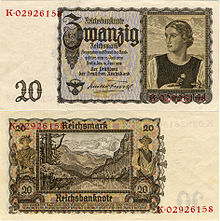Austrian schilling
| Shilling | |||
|---|---|---|---|
|
|||
| Country: |
|
||
| Subdivision: | 100 groschen | ||
| ISO 4217 code : | ATS | ||
| Abbreviation: | S, öS | ||
|
Exchange rate : (fixed) |
1 EUR = 13.7603 ATS |
||
| Issuer : | OeNB | ||
The schilling was the currency of the Republic of Austria from 1925 to 1938 and from 1945 until the introduction of the euro on January 1 , 1999 and then legal tender until February 28, 2002 . After Austria was " annexed " to the German Reich in March 1938 (see also: Austria in the time of National Socialism ), the Reichsmark was the currency until 1945.
The shilling was divided into 100 groschen .
Introduction, First Republic and Corporate State (until 1938)
The Schilling , with the shilling bill law adopted December 20, 1924, introduced on March 1, 1925 replaced by inflation following the First World War devalued currency of the Austro-Hungarian monarchy , the crown . At the end of 1922, the federal government Seipel I was granted a loan of 650 million gold crowns in the Geneva Protocols by the states of the League of Nations . In return, Austria had to undertake to shut down the printing press and submit to the financial control of the League of Nations.
On November 14, 1922, the Oesterreichische Nationalbank was founded (it replaced the " Austro-Hungarian Bank, Austrian Management " which was in liquidation ), whose most important task was to ensure the stability of the currency. By law (BGBl 461/1924) the value of the shilling was then set at 10,000 (paper) crowns or 0.21172086 grams of fine gold (with an unlimited redemption obligation), after a law of December 21, 1923 (BGBl 635 / 1923) 10,000 kroner silver coins called "shillings" (and corresponding half and double shillings of 5,000 and 20,000 kroner, respectively) were minted.
According to the wording of the law, however, the obligation to redeem existed only in the direction that gold bars could be exchanged for notes. It was also stipulated that "federal gold coins" must be minted at the specified standard, but the law does not state that these gold coins can be obtained at face value at any time.
Interestingly, even after the currency changeover, the National Bank was allowed to issue banknotes denominated in kroner until the end of 1926 (although in practice the value was given in both currencies.)
Five days after Austria's "annexation" to the German Reich, on March 17, 1938, the schilling was replaced by the Reichsmark. The exchange rate was 1.50 Schilling = 1 Reichsmark.
The Oesterreichische Nationalbank lost the banknote privilege on April 25th.
On November 30, 1945, the shilling became the national currency again . It remained so until the introduction of the euro . One shilling was equivalent to 100 groschen . Originally, the Stüber was planned instead of the Groschen , whereby the Schilling and Groschen are historically the same unit (12 Pfennig / Pence / Denare or in Southern Germany and Austria 30 Pfennig).
Coins 1925–1938
In the First Republic and in the corporate state there were coins of 1, 2, 5, 10, 50 groschen and ½, 1, 2, 5 shillings and banknotes of 5, 10, 20, 50, 100 and 1000 shillings. In 1926 gold coins to the value of 25 and 100 schillings were issued. Since the shilling developed into a stable currency, the popular name of the Alpine dollar established itself .
| Face value | Value side | Image side | diameter | Weight | material | First edition | Invalid from | information |
|---|---|---|---|---|---|---|---|---|
| 1 penny |

|
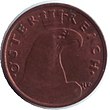
|
17 mm | 1.6 g | 95% Cu 4% Sn 1% Zn |
March 1, 1925 | Design: Heinrich Zita | |
| 2 groschen |

|

|
19 mm | 3.3 g | 95% Cu 4% Sn 1% Zn |
March 1, 1925 | Design: Philipp Häusler | |
| 5 groschen |

|

|
17 mm | 3.0 g | 75% Cu 25% Ni |
January 21, 1931 | Design: Philipp Häusler | |
| 10 groschen |
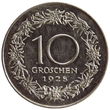
|

|
22 mm | 4.5 g | 75% Cu 25% Ni |
1925 | Design: Heinrich Zita | |
| 1 ⁄ 2 shillings |
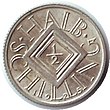
|

|
19 mm | 3.0 g | 64% Ag 36% Cu |
September 19, 1925 | Design: Philipp Häusler | |
| 50 groschen |
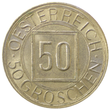
|

|
24 mm | 5.5 g | 75% Cu 25% Ni |
August 1, 1934 | Design: Gudrun Baudisch (WS), Michael Powolny (Adler) | |
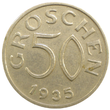
|

|
24 mm | 5.5 g | 75% Cu 25% Ni |
January 21, 1935 | Design: Gudrun Baudisch (WS), Michael Powolny (Adler) | ||
| 1 shilling |

|

|
26 mm | 7.0 g | 80% Ag 20% Cu |
June 16, 1924 | December 31, 1926 | Design: Heinrich Zita |

|

|
25 mm | 6 g | 64% Ag 36% Cu |
July 1, 1925 | |||

|

|
26 mm | 7 g | 75% Cu 25% Ni |
August 1, 1934 | Design: Gudrun Baudisch (WS), Michael Powolny (Adler) | ||
| 2 shillings |

|

|
29 mm | 12.0 g | 64% Ag 36% Cu |
1928 | different motives; Design value side: Edwin Grienauer ; List see double schilling | |

|

|
29 mm | 12.0 g | 64% Ag 36% Cu |
1934 | different motives; Design value side: Michael Powolny | ||
| 5 shillings |

|

|
31 mm | 15.0 g | 83.5% Ag 16.5% Cu |
August 1, 1934 | Design: Michael Powolny (WS), Edwin Grienauer (Madonna) | |
| 25 shillings |

|

|
21 mm | 5.9 g | 90% Au 10% Cu |
1926 | Design: Arnold Hartig | |

|
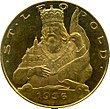
|
21 mm | 5.9 g | 90% Au 10% Cu |
1935 | Design: Michael Powolny | ||
| 100 shillings |

|

|
33 mm | 23.5 g | 90% Au 10% Cu |
1926 | Design: Arnold Hartig | |

|

|
33 mm | 23.5 g | 90% Au 10% Cu |
1935 | Design: Michael Powolny (WS), Edwin Grienauer (Madonna) |
Banknotes 1925–1938
Between 1925 and 1938 there were banknotes of 5, 10, 20, 50, 100 and 1000 shillings. In the first Schilling series from 1925, the plural of Schilling was still called Schillings. The last 100 Schilling note of the 1st Republic, which was printed in 1936, was no longer issued because of the annexation of Austria .
| Face value | front | back | Motif front | Motif back | format | pressure | First edition | Außerkurs- reduction |
Pre- inclusive period (invalid from) |
design |
|---|---|---|---|---|---|---|---|---|---|---|
| Series 1925 | ||||||||||
| 5 shillings |

|
153 × 81 mm | January 2, 1925 | June 8, 1925 | July 31, 1928 | July 31, 1931 | Rudolf Junk , Karl Sterrer | |||
| 10 shillings |

|
166 × 85 mm | January 2, 1925 | April 27, 1925 | January 31, 1928 | January 31, 1931 | Rudolf Junk, Karl Sterrer | |||
| 20 shillings |

|
179 × 90 mm | January 2, 1925 | July 1, 1925 | June 30, 1929 | June 30, 1932 | Rudolf Junk, Karl Sterrer | |||
| 100 shillings |

|
193 × 93 mm | January 2, 1925 | March 26, 1925 | June 30, 1929 | June 30, 1932 | Rudolf Junk, Karl Sterrer | |||
| 1000 shillings |

|
205 × 98 mm | January 2, 1925 | May 11, 1925 | March 31, 1932 | March 31, 1935 | Rudolf Junk, Karl Sterrer | |||
| Series 1927 | ||||||||||
| 5 shillings |

|
young man with compass | Erzberg | 110 × 65 mm | July 1, 1927 | October 24, 1927 | January 31, 1936 | December 31, 1938 | Rudolf Junk, Karl Sterrer | |
| 10 shillings |

|
Mercury | Mermaid , Dürnstein | 70 × 124 mm | January 3, 1927 | March 7, 1927 | January 31, 1936 | December 31, 1938 | Berthold Löffler | |
| 20 shillings |
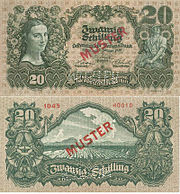
|
Pre-alpine landscape with sowing farmer and the mountains of the Salzkammergut | 139 × 76 mm | January 2, 1928 | April 23, 1928 | May 15, 1938 | December 31, 1938 | Wilhelm Dachauer | ||
| 50 shillings |

|
Karlskirche | 157 × 79 mm | January 2, 1929 | June 17, 1929 | November 30, 1936 | December 31, 1938 | Alfred Cossmann | ||
| 100 shillings |
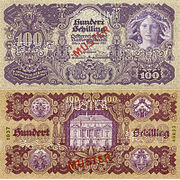
|
Academy of Science | 170 × 85 mm | January 3, 1927 | December 5, 1927 | May 15, 1938 | December 31, 1938 | Wilhelm Dachauer | ||
| 1000 shillings |

|
Salzburg with Hohensalzburg Fortress | 193 × 90 mm | January 2, 1930 | May 15, 1931 | May 15, 1938 | December 31, 1938 | Fritz Zerritsch | ||
| Series 1933 | ||||||||||
| 10 shillings |

|
Aggstein ruin , Wachauerin (model Johanna Nestor ) | Grossglockner | 70 × 125 mm | January 2, 1933 | April 9, 1934 | May 15, 1938 | December 31, 1938 | Arthur Brusenbauch | |
| 50 shillings |

|
Maria Wörth church complex | 157 × 79 mm | January 2, 1935 | June 8, 1936 | May 15, 1938 | December 31, 1938 | Obv .: Rudolf Junk, Karl Sterrer, Rev .: Rudolf Junk, Josef Seger |
||
| 100 shillings |

|
Woman with edelweiss | Gosausee with Dachstein | 175 × 87 mm | January 2, 1936 | not issued | Rudolf Junk, Josef Seger | |||
Intermezzo Reichsmark
After Austria was " annexed " to the Third Reich , the schilling was replaced by the Reichsmark on May 15, 1938 with an exchange value of 1 RM = 1.50 schilling . All gold stocks were requisitioned by the Reichsbank and the function of the Oesterreichische Nationalbank was dissolved. In the opinion of the Oesterreichische Nationalbank, this exchange rate had been set favorably for Austrian approval of the connection.
The draft of a 100 Schilling note from 1936 was reflected in the 20 Reichsmark note from 1939 (issued in 1945).
Second republic
After the unconditional surrender of the German Wehrmacht in early May 1945 and the subsequent occupation of Austria , the Allied Commission immediately sought to replace the Reichsmark with the former Schilling currency. Unlike in Italy or Germany, the national currency had to go through the "Allied Military Currency" ( Allied Military Schilling , pressure in 1944 US ) does not support, but completely at the exchange rate of 1: displaced first "Reichsmark" occupation money was only issued in the Soviet occupation zone .
As early as June 28, 1945, new Schilling stamps printed by the Allies could be issued. The “Schilling Act” of November 30, 1945 regulated the exchange of remaining Reichsmark stocks at the end of the year (max. 150 RM per capita), and the Oesterreichische Nationalbank was able to reactivate old Schilling printing plates from the last pre-war series for banknote production.
In 1947 the schilling was devalued by a third. In addition, a part of the savings was siphoned off by the state (was used for the reconstruction of Austria).
Allied military authority banknotes 1945
In 1945 the allied military authorities issued banknotes of 50 groschen, 1, 2, 5, 10, 20, 25, 50, 100 and 1000 schillings in the western occupation zones (France, Great Britain, USA). The 25-schilling note was only circulated in the British zone.
| Face value | Value side | Image side | format | pressure | First edition | Außerkurs- reduction |
Pre- inclusive period (invalid from) |
design |
|---|---|---|---|---|---|---|---|---|
| 50 groschen |

|

|
115 × 59 mm | 1944 | May 1945 | December 24, 1947 | ?? | ?? |
| 1 shilling |

|

|
115 × 59 mm | 1944 | May 1945 | December 24, 1947 | ?? | ?? |
| 2 shillings |

|

|
115 × 59 mm | 1944 | May 1945 | December 24, 1947 | ?? | ?? |
| 5 shillings |

|

|
114 × 73 mm | 1944 | May 1945 | December 24, 1947 | ?? | ?? |
| 10 shillings |

|
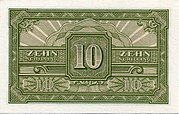
|
114 × 73 mm | 1944 | May 1945 | December 20, 1945 | ?? | ?? |
| 20 shillings |

|
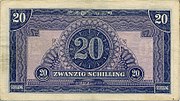
|
138 × 77 mm | 1944 | May 1945 | December 20, 1945 | ?? | ?? |
| 25 shillings |

|

|
138 × 77 mm | 1944 | May 1945 | December 20, 1945 | ?? | ?? |
| 50 shillings |

|

|
138 × 77 mm | 1944 | May 1945 | December 20, 1945 | ?? | ?? |
| 100 shillings |

|

|
151 × 85 mm | 1944 | May 1945 | December 20, 1945 | ?? | ?? |
| 1000 shillings |

|

|
151 × 85 mm | 1944 | May 1945 | December 20, 1945 | ?? | ?? |
Three other banknotes were prepared in the Soviet zone. However, only one banknote was actually issued.
| Face value | front | back | format | pressure | First edition | Außerkurs- reduction |
Pre- inclusive period (invalid from) |
design |
|---|---|---|---|---|---|---|---|---|
| 50 Reichspfennig |
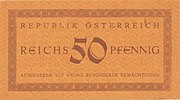
|

|
100 × 55 mm | (1945) | not issued (the illustration is a test print; the reverse looks like the 1 Reichsmark note) | ?? | ||
| 1 Reichsmark |

|

|
100 × 55 mm | (1945) | December 1945 | December 20, 1945 | December 31, 1945 | ?? |
| 2 Reichsmarks |

|

|
97.5 x 53.5 mm | (1945) | not issued | ?? | ||
Coins 1945–2002
There were coins of 1, 2, 5, 10, 20 (at times) and 50 groschen as well as 1, until 1957 also 2 shillings, with increasing devaluation later also 5, 10, 20, 25, 50, 100, 200, 500 and 1000 shillings. The higher values (25–1000 S) were primarily collector's items made entirely of silver or gold alloy and, apart from the 25 S piece, had counterparts made of paper of equal value. The twenty-schilling coin was introduced in 1980 in addition to the 20-S banknote specifically for vending machines, but was hardly accepted by the population. Therefore, machines were hardly set up for this and after the euro changeover, the call for a two-euro banknote (the value of a good 27 S) was very loud.
Shilling coins
The one-shilling coin was made of aluminum after the war; there was also a slightly larger two-shilling coin made of aluminum until 1957. From 1959 a smaller shilling was made from aluminum bronze, its image was the body of Sparefroh , an advertising figure of the savings banks. The ten schilling coin replaced the equivalent banknote in the 1960s. It was originally made of silver, but in 1974 it was converted to a cheaper copper-nickel alloy, similar to the previous five-schilling coin , due to the higher price of silver (above nominal) . When the increase in the price of silver was foreseeable, silver fives and silver tens were collected from the rest of the circulation by private individuals.
Groschencoins
The one-, two-, five-, ten- and fifty-groschen pieces were valid for the groschen until the introduction of the euro, but they were less and less in circulation due to the rise in prices. After the reintroduction of the shilling, the 1- Reichspfennig pieces were equated 1: 1 with new 1-groschen pieces, so production and conversion costs could be reduced. The 1 groschen coin itself was only minted briefly around 1947, many Reichspfennige were also minted with the new image. Since the 1 groschen coins issued since 1948 disappeared from the market and their production was discontinued - they were already a rarity in the 1960s - but they were never formally suspended, the Reichspfennige remained theoretically legal tender until the euro changeover. Although the two-penny coin was only used in trade until around 1970, it was minted until the 1990s, mainly for collector's sets. In 2002 the aluminum scrap value had reached the nominal value of 2 groschen.
Silver and gold coins

Silver coins were minted to the value of 25 , 50 , 100 , 200 and 500 schillings, gold coins to 200, 500, 1000 and 2000 schillings. They were considered normal means of payment, but were rarely found in normal payment transactions. Many pieces were only produced in special degrees of preservation such as the proof and were only sold above face value. They are still coveted collectibles. An exception is the Vienna Philharmonic , which was minted in the schilling denomination until 2001.
value
After the collapse of the Bretton Woods system in 1971, the shilling was pegged to a basket of multiple currencies. In July 1976, it was finally linked to the extremely stable Deutsche Mark . Although this link was never officially announced, the Oesterreichische Nationalbank carried out all exchange rate movements parallel to the D-Mark, since Germany - then as now - was Austria's most important trading partner.
Abbreviations
The abbreviations used in general and in Austrian law were S and g . The abbreviation öS was used abroad . The abbreviation for the currency according to ISO 4217 , which became widespread after the computerization of the banks, was ATS . In handwriting, the Schilling-S was often written with clear serifs .
Coins
| Face value | front | back | diameter | Weight | material | First edition | invalid from | information |
|---|---|---|---|---|---|---|---|---|
| 1 penny |
|
|
17 mm | 1.8 g | Zn | April 5, 1948 | Design: Adolf Hofmann (WS), Michael Powolny (RS) | |
| 2 groschen |
|
|
18 mm | 0.9 g | 98.5% Al , 1.5% Mg | July 15, 1950 | Design: Benno Rost (WS), Michael Powolny (RS) | |
| 5 groschen |
|
|
19 mm | 2.5 g | Zn | June 17, 1948 | Design: Adolf Hofmann (WS), Michael Powolny (BS) | |
| 10 groschen |
|
|
21 mm | 3.5 g | Zn | July 1, 1947 | May 31, 1959 | Design: Adolf Hofmann (WS), Michael Powolny (BS) |
|
|
|
20 mm | 1.1 g | 98.5% Al, 1.5% Mg | November 27, 1951 | Design: Hans Köttenstorfer | ||
| 20 groschen |
|
|
22 mm | 4.5 g | 91.5% Cu , 8.5% Al | December 23, 1950 | April 30, 1959 | Design: Benno Rost (WS), Michael Powolny (RS) |
| 50 groschen |
|
|
22 mm | 1.4 g | 98.5% Al, 1.5% Mg | December 11, 1947 | June 2, 1961 | Design: Michael Powolny |
|
|
|
19.5 mm | 3.0 g | 91.5% Cu, 8.5% Al | October 1, 1959 | Design: Josef Kölblinger (WS), Ferdinand Welz (RS) | ||
| 1 shilling |

|

|
25 mm | 2.0 g | 98.5% Al, 1.5% Mg | December 11, 1947 | May 2, 1961 | Design: Michael Powolny |
|
|
|
22.5 mm | 4.2 g | 91.5% Cu, 8.5% Al | September 1, 1959 | Design: Edwin Grienauer (WS), Ferdinand Welz (RS) | ||
| 2 shillings |

|

|
28 mm | 2.8 g | 98.5% Al, 1.5% Mg | December 11, 1947 | June 29, 1957 | Design: Michael Powolny |
| 5 shillings |

|

|
31 mm | 4.0 g | 98.5% Al, 1.5% Mg | October 25, 1952 | February 15, 1961 | Design: Michael Powolny |
|
|
|
23.5 mm | 5.2 g | 64% Ag , 36% Cu | January 2, 1961 | September 30, 1969 | Corrugation; Design: Hans Köttenstorfer (WS), Josef Kölblinger (RS) | |
| 23.5 mm | 4.8 g | 75% Cu, 25% Ni | 15th January 1969 | smooth edge | ||||
| 10 shillings |

|

|
27 mm | 7.5 g | 64% Ag, 36% Cu | July 1, 1957 | March 31, 1975 | Design: Ferdinand Welz |

|
26 mm | 6.2 g | 75% Cu, 25% Ni | April 17, 1974 | Front unchanged - back: stylized federal coat of arms ; Designed by Kurt Bodlak | |||
| 20 shillings |

|

|
27.7 mm | 8.0 g | 92% Cu, 6% Al, 2% Ni | December 10, 1980 | A series of 20 Schilling course coins as a planned replacement for the 20 Schilling note, a total of 18 different motifs, see list of Austrian 20 Schilling course coins |
|
| 25 shillings silver coin |

|

|
30 mm | 13 g | 80% Ag, 20% Cu | October 1, 1955 | Three different value pages, a total of 19 different motifs, see the list of Austrian 25 Schilling commemorative issues |
|
| 50 shillings silver coin |

|

|
34 mm | 20 g | 1959-1973: 90% Ag, 10% Cu 1974-1978: 64% Ag, 36% Cu |
February 20, 1959 | Three different value pages, a total of 20 different motifs, see list of Austrian 50 schilling commemorative issues |
|
| 50 Schilling bimetal coin |

|

|
26.5 mm | 8.15 g | Bimetal: ring: 92% Cu, 6% Al, 2% Ni; Inner part: Magnimat 7 |
1996 | uniform value side, nine different image sides, see list of Austrian 50 schilling commemorative issues |
|
| 100 shillings silver coin |
 
|
 
|
1974–79: 36 mm from 1991: 34 mm |
1974-79: 24 g from 1991: 20 g |
1974-1979: 64% Ag, 36% Cu from 1991: 90% Ag, 10% Cu |
23rd December 1974 | Various variants of the value side; 24 issues from 1974–1979; 18 issues in different series from 1991 see list of Austrian 100 Schilling commemorative issues |
|
| 100 Schilling bimetal coin | 34 mm | 13.75 g | Bimetal: ring: 90% Ag, 10% Cu; Inner part: 100% titanium |
January 19, 2000 | 2 issues from 2000–2001 see list of Austrian bimetallic schilling commemorative issues |
|||
| 200 shillings silver coin |

|
40 mm | 33.63 g | 92.5% Ag, 7.5% Cu | January 12, 1995 | uniform value side, two different image sides, see list of Austrian 200 Schilling commemorative issues |
||
| 200 Schilling gold coin | 16 mm | 3.121 g | 99.99% Au , 0.1% Cu | 1991 | From 1991 to 2001 Philharmonic, see Gold Philharmonic |
|||
| 500 shillings silver coin |

|

|
1980–1982: 38 mm from 1983: 37 mm |
24 g | 1980-1982: 64% Ag, 36% Cu from 1983: 92.5% Ag, 7.5% Cu |
April 10, 1980 | From 1980 to 1988 34 issues with uniform value side; from 1989 26 further issues with freely designed value and picture pages see list of Austrian 500 Schilling commemorative issues |
|
| 500 Schilling bimetal coin | 30 mm | 13.4 g | Bimetal: ring: 98.6% Au, 1.4% Cu; Inner part: 90% Ag, 10% Cu |
March 24, 1995 | see list of Austrian bimetal schilling commemorative editions | |||
| 500 Schilling gold coin | 22 mm | 8.1136 g | 98.6% Au, 1.4% Cu | January 24, 1991 | From 1991 to 2001 10 issues with freely designed value and picture pages see list of Austrian 500 Schilling gold coins |
|||
| 22 mm | 7.7759 g | 99.99% Au, 0.01% Cu | 1989 | From 1989 to 2001 Philharmonic, see Gold Philharmonic |
||||
| 1000 Schilling bimetal coin | 40 mm | 40 g | Bimetal: ring: 90% Ag, 10% Cu; Inner part: 98.6% Au, 1.4% Cu |
May 31, 1994 | see list of Austrian bimetal schilling commemorative editions | |||
| 1000 Schilling gold coin |

|

|
27 mm | 13.5 g | 90.0% Au, 10.0% Cu | October 22, 1976 | see federal gold coin | |
| 28 mm | 16.97 g | 91.67% Au, 8.33% Cu | January 12, 1995 |
For the IOC coin, see the list of Austrian 1000 Schilling gold coins |
||||

|
30 mm | 16.225 g | 98.6% Au, 1.4% Cu | May 15, 1991 | From 1991 to 2001 10 issues with freely designed value and picture pages see the list of Austrian 1000 Schilling gold coins |
|||
| 28 mm | 15.55 g | 99.99% Au, 0.01% Cu | 1994 | From 1994 to 2001 Philharmonic, see Gold Philharmonic |
||||
| 2000 Schilling gold coin | 37 mm | 31.1035 g | 99.99% Au , 0.1% Cu | 1989 | From 1989 to 2001 Philharmonic, see Gold Philharmonic |
Banknotes 1945–2002
| Face value | front | back | Motif front | Motif back | format | pressure | First edition | Außerkurs- reduction |
Pre- inclusive period (invalid from) |
design |
|---|---|---|---|---|---|---|---|---|---|---|
| Interim notes 1945 (issued until the Currency Protection Act came into force ) | ||||||||||
| 10 shillings |

|
Aggstein ruin , Wachauerin (model Johanna Nestor ) | Grossglockner | 68 × 122 mm | May 29, 1945 | December 13, 1945 | December 24, 1947 | December 24, 1947 | Arthur Brusenbauch | |
| 20 shillings |
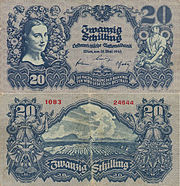
|
Pre-alpine landscape with sowing farmer and the mountains of the Salzkammergut | 137 × 73 mm | May 29, 1945 | December 13, 1945 | December 24, 1947 | December 24, 1947 | Wilhelm Dachauer | ||
| 100 shillings |

|
Academy of Science | 164 × 85 mm | May 29, 1945 | December 13, 1945 | December 24, 1947 | December 24, 1947 | Wilhelm Dachauer | ||
| 1000 shillings |

|
Salzburg | 185 × 92 mm | May 29, 1945 | December 13, 1945 | December 24, 1947 | December 24, 1947 | Fritz Zerritsch | ||
| Interim notes 1947 (issued after the Currency Protection Act came into force) | ||||||||||
| 5 shillings |

|

|
young man with compass | Erzberg | 110 × 67 mm | September 4, 1945 | December 11, 1947 | February 27, 1954 | February 27, 1974 | Rudolf Junk, Karl Sterrer |
| 10 shillings |

|
Ruine Aggstein , Wachauerin (model Johanna Nestor ), second edition | Grossglockner | 68 × 132 mm | May 29, 1945 | December 11, 1947 | September 15, 1949 | 15th September 1969 | Arthur Brusenbauch | |
| 50 shillings |

|
Maria Wörth church complex | 154 × 78 mm | May 29, 1945 | December 11, 1947 | February 14, 1953 | February 14, 1973 | Obv .: Rudolf Junk, Karl Sterrer, Rev .: Rudolf Junk, Josef Seger |
||
| 100 shillings |

|
Second edition | Academy of Science | 177 × 85 mm | May 29, 1945 | December 11, 1947 | April 30, 1948 | April 30, 1968 | Wilhelm Dachauer | |
| 1000 shillings |

|

|
Second edition | Salzburg | 185 × 92 mm | September 1, 1947 | December 11, 1947 | June 29, 1957 | June 30, 1977 | Fritz Zerritsch |
| Series 1950 | ||||||||||
| 10 shillings |

|

|
Mint tower in Hall in Tirol | 125 × 70 mm | February 2, 1946 | August 25, 1949 | April 30, 1952 | April 30, 1972 | Josef Seger | |
| 20 shillings |

|

|
Vienna | 140 × 75 mm | February 2, 1946 | April 12, 1948 | June 30, 1951 | June 30, 1971 | Josef Seger | |
| 100 shillings |

|

|
Gosausee in front of Dachstein ( Upper Austria ) | 165 × 83 mm | January 2, 1947 | January 28, 1948 | February 27, 1954 | February 27, 1974 | Josef Seger | |
| 100 shillings |

|
Vienna and Danube | 176 × 85 mm | January 3, 1949 | November 3, 1949 | April 15, 1959 | April 15, 1979 | Erhard Amadeus-Dier | ||
| 100 shillings |

|
2nd Edition | Vienna and Danube | 176 × 85 mm | January 3, 1949 | July 7, 1952 | April 15, 1959 | April 15, 1979 | Erhard Amadeus-Dier | |
| Series 1950 | ||||||||||
| 5 shillings |

|
young man with compasses, 1951 edition | Erzberg | 110 × 67 mm | September 4, 1945 | 1951 | February 27, 1954 | February 27, 1974 | Rudolf Junk, Karl Sterrer | |
| 10 shillings |

|

|
Spanish Riding School | Belvedere Palace , no edition designation | 132 × 65 mm | January 2, 1950 | May 26, 1951 | April 15, 1959 | April 15, 1979 | Obv .: Rupert Franke , Rev .: Erhard Amadeus-Dier |
| 10 shillings |

|

|
Spanish Riding School | Belvedere Palace , 2nd edition | 132 × 65 mm | January 2, 1950 | September 24, 1954 | April 15, 1959 | April 15, 1979 | Obv .: Rupert Franke, Rev .: Erhard Amadeus-Dier |
| 20 shillings |

|

|
Joseph Haydn | Calvary Eisenstadt | 148 × 70 mm | January 2, 1950 | September 25, 1950 | June 29, 1957 | June 30, 1977 | Erhard Amadeus-Dier |
| 50 shillings |

|

|
Jakob Prandtauer | Melk Abbey | 164 × 75 mm | January 2, 1951 | October 25, 1952 | April 30, 1964 | April 30, 1984 | Obv .: Erhard Amadeus-Dier, Hedwig zum Tobel , Rev .: Erhard Amadeus-Dier, Rupert Franke |
| 100 shillings |

|

|
Franz Grillparzer | Dürnstein | 176 × 85 mm | January 2, 1954 | October 14, 1955 | April 30, 1964 | April 30, 1984 | Josef Franz Renner |
| 500 shillings |

|

|
Julius Wagner-Jauregg | University of Vienna | 186 × 88 mm | January 2, 1953 | 5th December 1953 | September 30, 1967 | September 30, 1987 | Josef Franz Renner |
| 1000 shillings |

|

|
Anton Bruckner | Bruckner organ, St. Florian Monastery | 192 × 89 mm | January 2, 1954 | January 23, 1956 | April 30, 1964 | April 30, 1984 | Roman Hellmann and Erhard Amadeus-Dier |
| Series 1956 | ||||||||||
| 20 shillings |

|

|
Carl Auer von Welsbach | Maria Rain (Carinthia) | 132 × 65 mm | 2nd July 1956 | 3rd December 1956 | February 28, 1970 | February 28, 1990 | Roman Hellmann |
| 50 shillings |

|

|
Richard Wettstein | Mauterndorf Castle | 140 × 70 mm | July 2nd, 1962 | March 11, 1963 | February 28, 1973 | February 28, 1993 | Roman Hellmann |
| 100 shillings |

|

|
Johann Strauss | Schönbrunn Castle | 150 × 75 mm | July 1, 1960 | September 25, 1961 | March 31, 1972 | March 31, 1992 | Roman Hellmann |
| 1000 shillings | Viktor Kaplan , white variant | Ybbs-Persenbeug power plant | 150 × 75 mm | January 2, 1961 | 5th February 1962 | April 30, 1962 | April 30, 1982 | Roman Hellmann | ||
| 1000 shillings |

|
Viktor Kaplan , blue variant | Ybbs-Persenbeug power plant | 160 × 84 mm | January 2, 1961 | November 26, 1962 | March 31, 1972 | March 31, 1992 | Roman Hellmann | |
| Series 1966 | ||||||||||
| 20 shillings |

|

|
Carl von Ghega | Semmering Railway | 132 × 65 mm | 2nd July 1967 | 4th November 1968 | September 30, 1989 | September 30, 2009 | Roman Hellmann |
| 50 shillings |

|

|
Ferdinand Raimund | Burgtheater | 140 × 70 mm | January 2, 1970 | February 15, 1972 | August 31, 1988 | August 31, 2008 | Roman Hellmann |
| 50 shillings |

|
Ferdinand Raimund , 2nd edition | Burgtheater | 140 × 70 mm | January 2, 1970 | September 19, 1983 | August 31, 1988 | August 31, 2008 | Roman Hellmann | |
| 100 shillings |

|

|
Angelika Kauffmann | Bregenzerwälderhaus | 150 × 75 mm | January 2, 1969 | 19th October 1970 | November 28, 1986 | November 28, 2006 | Roman Hellmann |
| 100 shillings |

|
Angelika Kauffmann , 2nd edition | Bregenzerwälderhaus | 150 × 75 mm | January 2, 1969 | June 1, 1981 | November 28, 1986 | November 28, 2006 | Roman Hellmann | |
| 500 shillings |

|

|
Joseph Ressel | Steamship Civetta | 155 × 80 mm | July 1, 1965 | October 24, 1966 | August 31, 1987 | August 31, 2007 | Roman Hellmann |
| 1000 shillings |

|

|
Bertha von Suttner | Leopoldskron , Hohensalzburg | 159 × 84 mm | July 1, 1966 | September 21, 1970 | August 30, 1985 | August 30, 2005 | Roman Hellmann |
| 1983 series | ||||||||||
| 20 shillings |

|

|
Moritz Daffinger | Albertina | 123 × 62 mm | October 1, 1986 | October 19, 1988 | February 28, 2002 | unlimited | Robert Kalina |
| 50 shillings |

|

|
Sigmund Freud | Josephinum | 130 × 65 mm | January 2, 1986 | October 19, 1987 | February 28, 2002 | unlimited | Robert Kalina |
| 100 shillings |

|

|
Eugen Boehm von Bawerk | Auditorium of the Old University of Vienna , built from 1735 to 1755 by Jean Nicolas Jadot de Ville-Issey , since 1857 the seat of the Academy of Sciences . | 137 × 68.5 mm or 138 × 68 mm | January 2, 1984 | October 14, 1985 | February 28, 2002 | unlimited | Robert Kalina |
| 500 shillings |

|

|
Otto Wagner | Wiener Postsparkasse | 144 × 72 mm | July 1, 1985 | June 20, 1986 or October 20, 1986 | April 20, 1998 | April 20, 2018 | Robert Kalina |
| 1000 shillings |

|

|
Erwin Schrödinger | University of Vienna | 152 × 76 mm | January 3, 1983 | November 14, 1983 | April 20, 1998 | April 20, 2018 | Robert Kalina |
| 5000 shillings |

|

|
Wolfgang Amadeus Mozart and stylized view of Salzburg . | Vienna State Opera | 160 × 80 mm | January 4, 1988 | 17th October 1989 | February 28, 2002 | unlimited | Robert Kalina |
| 1997 series | ||||||||||
| 500 shillings |

|

|
Rosa Mayreder | Rosa and Karl Mayreder , group picture of the participants in the Bundestag Austrian women's associations in Vienna in 1911. | 148 × 72 mm | January 1, 1997 | October 20, 1997 | February 28, 2002 | unlimited | Robert Kalina |
| 1000 shillings |

|

|
Karl Landsteiner | Karl Landsteiner in his laboratory in the Pathological-Anatomical Institute of the University of Vienna. Model of a poliovirus and stylized form of the blood grouping process . | 154 × 72 mm | January 1, 1997 | October 20, 1997 | February 28, 2002 | unlimited | Robert Kalina |
Had the schilling been retained as the currency, new issues of the 20, 50, 100 and 5000 Schilling banknotes would have been produced, to match the new 500 and 1000 S notes introduced in 1997. On them were Gustav Klimt , Ida Pfeiffer , Franz Schubert and Marie von Ebner-Eschenbach been mapped.
End of the shilling currency in 1999/2002
On January 1, 1995, Austria joined the European Union and successfully applied to participate in the planned common currency.
Euro rate
The schilling was replaced as book money on January 1, 1999 by the euro . The exchange rate to the euro agreed with the other euro countries, which had not changed until the changeover to cash, was 1 euro = 13.7603 schillings.
Schilling exchange
The cash introduction of the euro took place on January 1st, 2002; the rate for historical conversions remained unchanged. The schilling remained legal tender on an equal footing with the euro until February 28, 2002.
The banks exchanged shilling coins and banknotes for euros for another year. Even beyond this year, department store chains held trade-in campaigns that could still be paid for in shillings. For several years now, the OeNB has been organizing a “Euro Info Tour” where old Schilling stocks can be exchanged for euros at a mobile branch in many Austrian municipalities. Despite such campaigns, as of December 31, 2014, there were still schilling stocks worth 630.3 million euros, including 283 million euros in schilling coins. The owners were not known.
The most recently valid notes and coins are exchanged for an unlimited period - and free of charge - by the Oesterreichische Nationalbank . There was / is a time-limited exchange period for all older notes. The 500 schilling note from 1986 (with the image of Otto Wagner ) and the 1000 schilling note from 1983 (with the image of Erwin Schrödinger ) could be exchanged until April 20, 2018. Of these banknotes, which were limited in time until 2018, the equivalent of 112.6 million euros were still outstanding at the end of 2014. All older banknotes can no longer be exchanged; for example, the exchange period for the 1000 Schilling banknote from 1966 with the image of Bertha von Suttner expired on August 30, 2005. According to the National Bank, there were still 463,000 units in circulation at that time, corresponding to a value of 33.6 million euros. At the end of the exchange period, the corresponding value of the outstanding banknotes was paid into the federal budget by the National Bank, i.e. these were written off as lost and booked out.
Banknotes with a time-limited exchange (preclusive periods)
The banknotes of the last Schilling series, which were the current legal tender in Austria at the time the euro was introduced.
- 20 Schilling (V. Form) - Moritz Daffinger
- 50 Schilling (IV. Form) - Sigmund Freud
- 100 Schilling (VI. Form) - Eugen Boehm von Bawerk
- 500 Schilling (IV. Form) - Rosa Mayreder
- 1,000 Schilling (V. Form) - Karl Landsteiner
- 5,000 Schilling (I. Form) - Wolfgang Amadeus Mozart
Expired exchange periods for the 1966 series and 1983 series
- 1,000 S / III. Form Bertha von Suttner - August 30, 2005
- 500 S / II. Form Josef Ressel - August 31, 2007
- 100 S / V. Form Angelika Kauffmann - November 28, 2006
- 100 S / V. Form (2nd edition) Angelika Kauffmann - November 28, 2006
- 50 S / III. Form Ferdinand Raimund - August 31, 2008
- 50 S / III. Form (2nd edition) Ferdinand Raimund - August 31, 2008
- 20 S / IV. Form Carl Ritter von Ghega - September 30, 2009
- 1,000 S / IV. Form Erwin Schrödinger - April 20, 2018
- 500 S / III. Form Otto Wagner - April 20, 2018
Monetary value 2009
One schilling or one Reichsmark in 2009 corresponded to the following current monetary value:
- S-prices 1930: € 2.96
- RM prices in 1938: € 4.68
- RM prices in 1944: € 3.74
- S-prices 1955: € 0.46
- S-prices 1970: € 0.28
- S-prices 1980: 0.15 €
- S-prices 1990: 0.11 €
- S-prices 1999: € 0.09 (1999 converted to € 0.07267; inflation rate since: 22%, corresponds to around 2% per year)
useful information
The change from the crown to the shilling took place smoothly until July 1, 1926. The following official notification was issued for the last possible change:
“From now on you have to settle in shillings and groschen. Offenders will be punished with 60,000 crowns. "
The year of minting is missing from the 50 Schilling coin from the year 1999 Johann Strauss .
There are two variants of the 20 schilling banknote from the year of issue 1950: one with a spelling mistake “OESTERREICHISCEE” and one without a spelling mistake “OESTERREICHISCHE” in the lower left and right underprint on the front. Amazingly, the variant without spelling mistakes is the rarer one and therefore also the more expensive one among collectors.
The white variant of the 1000 Schilling note from 1961 is the most expensive Austrian banknote from the Second Republic. It was only in circulation for a few months because it had the same format as the 100 Schilling note and was therefore often confused with it. It was withdrawn and replaced by a slightly larger blue note with the same image.
Based on the representation of the viaduct over the Kalte Rinne on the 20 schilling note from 1968, the following joke was circulating in Upper Austria around 1970/1980: Person A: “Have you seen the cyclist on the bridge?” / Person B: “Where? “/ A:“ Well here: Very small. Look closely ... "/ B:" No, I don't see him. "/ A:" Well, now he's gone, drove past ... "/ B is startled. / A: “Have you ever seen a cyclist on a railway bridge?” A laughs and refers to the words Semmering and Ghega on the front , which made it clear to practically everyone that it was a railway line .
In the train accident on the Südbahn on December 1, 2015, the affected freight train came to a stop exactly where the center of the picture of the 20 Schilling banknote from 1968 is. To the left and thus to the southwest in the direction of Semmering and Graz, driving with the front half of the train length at the Kalte-Rinne viaduct and - partially derailed - in the tunnel of the polleros wall to the right of the center of the picture. The picture shows the masts of the overhead line for electrification from 1959 on the viaduct.
The Schilling is sung about in the Viennese song “Du guater Schilling, pfiat di Gott”, written by Ludwig Prachtl and Franz Pelz .
In dialect the currency was u. a. with short forms like Schüü .
See also
- Shilling
- Currency reforms in Austria
- Gold crown
- List of Austrian Krone banknotes
- List of Austrian guilder banknotes
literature
- Karl Bachinger et al .: Farewell to the Schilling. An Austrian economic history . Verlag Styria, Graz-Vienna-Cologne 2001, ISBN 3-222-12872-3 .
Web links
- Entry on Austrian Schilling in the Austria Forum (in the AEIOU Austria Lexicon )
- Austrian banknotes on the side of the Oesterreichische Nationalbank
- Complete directory of schilling coins from 1947 to 2001 (PDF file, 5.1 MB)
- Overview of all Schilling banknotes from 1925
- colnect - catalog created by collectors (2003-2014)> Coins> Austria> 1945 ~ 2001 - 2nd Republic (Schilling) - Circulation coins (16)
- colnect - catalog created by collectors (2003–2014)> Banknotes> Series list Austria
- Valuable groschencoins geldmarie.at - production years, editions, rarity and collector's value
- Inflation cockpit - currency converter (Adobe Flash) (inflation-adjusted conversion of Austrian currencies since 1820 into today's euro)
Individual evidence
- ↑ From the Schilling to the Euro. Austrian National Bank, archived from the original on January 20, 2013 ; Retrieved June 1, 2013 .
- ↑ Overview of the coins in circulation from 1925 to 1938 ( Memento of February 3, 2011 in the Internet Archive ), Austrian Mint
- ^ Günter Schön: Small German Coin Catalog from 1871 to the present day Munich 2000
- ↑ Confiscation of the old Schilling coins. In: Die Neue Zeitung , December 31, 1926, p. 2 (online at ANNO ). "The originally pronounced Schillings with the year 1924 will finally be withdrawn from circulation on December 31, 1926 and will no longer be considered as legal tender from this point on."
- ↑ a b c d Johann Kodnar, Norbert Künstner: Catalog of Austrian banknotes from 1759, 3rd edition . Self-published, 2018, ISBN 978-3-9504334-1-8 , p. 192-205 .
- ^ Rudolf Richter: Paper money special catalog Austria 1759-2010 . Frühwald, 2010, ISBN 978-3-9502590-4-9 , p. 113-118 .
- ↑ Conversion of Reichsmarks into Schilling - website of the Oesterreichische Nationalbank ( Memento from November 28, 2010 in the Internet Archive )
- ^ FA Southard in: The finances of European liberation with special reference to Italy, pp. 37ff, Google Books
- ^ Allied Military Currency
- ^ First "Posthorn" stamp series 1945
- ↑ Johann Kodnar, Norbert Künstner: Catalog of the Austrian bank notes from 1759, 3rd edition . Self-published, 2018, ISBN 978-3-9504334-1-8 , p. 223-233 .
- ^ Rudolf Richter: Paper money special catalog Austria 1759-2010 . Frühwald, 2010, ISBN 978-3-9502590-4-9 , p. 127-131 .
- ↑ Johann Kodnar, Norbert Künstner: Catalog of the Austrian bank notes from 1759, 3rd edition . Self-published, 2018, ISBN 978-3-9504334-1-8 , p. 234-237 .
- ^ Rudolf Richter: Paper money special catalog Austria 1759-2010 . Frühwald, 2010, ISBN 978-3-9502590-4-9 , p. 132-133 .
- ↑ Schilling Law, State Law Gazette 1945/231, § 2 d
- ↑ Ordinance on the issue of 1 groschen coins, BGBl. 1948/61.
- ^ Parliamentary materials
- ↑ Overview of Austrian coins (Second Republic) up to February 28, 2002 ( memento of February 3, 2011 in the Internet Archive ), Austrian Mint
- ↑ a b c d Johann Kodnar, Norbert Künstner: Catalog of Austrian banknotes from 1759, 3rd edition . Self-published, 2018, ISBN 978-3-9504334-1-8 , p. 239-281 .
- ^ A b c Rudolf Richter: Paper money special catalog Austria 1759–2010 . Frühwald, 2010, ISBN 978-3-9502590-4-9 , p. 134-152 .
- ^ Banknote World Educational> Austria. Retrieved June 1, 2013 .
- ↑ § 2 of the Euro Act, Federal Law Gazette I No. 72/2000
- ↑ Cash in circulation. Retrieved June 10, 2015 .
- ^ Oesterreichische Nationalbank - Banknote Exchange. Retrieved June 1, 2013 .
- ^ Exchange of Schilling - OeNB
- ↑ Banknotes with a time-limited exchange - OENB on archive.org of April 5, 2003 ( Memento of April 5, 2003 in the Internet Archive )
- ^ First Austrian Spar-Casse (Ed.): Vienna, am Graben 21. 150 years of the First Austrian Spar-Casse, 150 years of Austrian history. Vienna 1969.
- ↑ Consumer price index 1966
- ↑ Notes on the Schilling nostalgia in the courier of June 8, 2011. Archived from the original on August 14, 2011 ; Retrieved June 9, 2011 . (The original article in the Kurier Archive ( Memento from October 30, 2014 in the Internet Archive ) is only accessible to subscribers.)
- ↑ Florian Schön: Austrian Schilling coin catalog , 2015.
- ↑ Johann Kodnar, Norbert Künstner: Catalog of the Austrian bank notes from 1759, 3rd edition . Self-published, 2018, ISBN 978-3-9504334-1-8 , p. 256 .
- ^ Rudolf Richter: Paper money special catalog Austria 1759-2010 . Frühwald, 2010, ISBN 978-3-9502590-4-9 , p. 142 .
- ↑ Overview of all Schilling banknotes from 1925 onwards. Accessed on September 22, 2015 .
- ↑ Die Geldmarie, The Little Kaplan Thousand. Retrieved November 13, 2017 .
- ↑ Note: If a cyclist were actually to be seen on the 184-meter-long Kalte-Rinne railway viaduct, shown with a length of about 30 millimeters, the length of the bike would be about two lithographic lines on the same scale.
- ↑ Freight train derailed on the southern railway line. , In: ORF .at, December 1, 2015.
- ↑ You good old Schilling on YouTube



